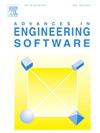应用n体系统设计的工程问题的不确定性量化:概述
IF 5.7
2区 工程技术
Q2 COMPUTER SCIENCE, INTERDISCIPLINARY APPLICATIONS
引用次数: 0
摘要
在进行计算密集型模型的不确定性量化时,有意识地选择输入随机变量的实现是至关重要的,以便完成每个模拟产生尽可能多的新信息。为了实现这一目标,在优化整个设计域输入采样点的均匀性方面投入了大量精力。本文的目的有三个:(i)它提供了设计最优性标准的回顾,重点是基于距离的标准,可以类比于n体系统,并包括与低差异设计的比较;(ii)首次证明,使用作者先前开发的n体优化算法Vořechovský等人(2019)、Vořechovský和Mašek(2020)获得的点样本表现出卓越的均匀性,优于现有方法生成的样本;(iii)它解释了过于天真地应用n体类比的潜在陷阱-例如忽略能量考虑,维度缩放和领域边界-以及识别有效计算实现的机会。我们证明,在研究和工程实践中,在数值分析中使用这些优化设计,要么导致估计精度的大幅增加,要么减少了实现所需估计误差所需的模型运行次数。将构建的点样本的性能与目前被研究人员和实践工程师认为是首选采样策略的采样方法进行了比较。结果表明,所提出的优化方法在鲁棒性和估计误差(方差减小)方面都优于现有的优化方法。本文还讨论了有限计算能力对大量点样本的固有限制。本文章由计算机程序翻译,如有差异,请以英文原文为准。
Uncertainty quantification of engineering problems using N-body system designs: An overview
When conducting an uncertainty quantification of computationally intensive models, it is vital that the realizations of the input random variables are consciously selected so that completing of each simulation yields as much new information as possible. To achieve that, a great effort is invested into optimization of uniformity of input sampling points across the design domain.
The purpose of this paper is threefold: (i) it provides a review of design optimality criteria, with a focus on distance-based criteria that can be viewed in analogy to N-body systems, and includes comparisons to low-discrepancy designs; (ii) it documents, for the first time, that point samples obtained using the authors’ previously developed N-body optimization algorithm Vořechovský et al. (2019), Vořechovský and Mašek (2020) exhibit exceptional uniformity and outperform samples generated by existing methods; and (iii) it explains potential pitfalls of applying N-body analogies too naively — such as neglecting energetic considerations, dimension scaling, and domain boundaries — as well as identifies opportunities for efficient computational implementation. We demonstrate that using these optimized designs in numerical analyses, both in research and engineering practice, leads to either a substantial increase in estimation precision or a reduction in the number of model runs required to achieve a desired estimation error. The performance of the constructed point samples is compared to the sampling methods that are today considered as go-to sampling strategies by researchers and practicing engineers. It is demonstrated that the proposed optimization method is superior to the state-of-the art methods in both robustness as well as estimation error (variance reduction). Inherent limitations for vast point samples posed by a finite computing power are also discussed.
求助全文
通过发布文献求助,成功后即可免费获取论文全文。
去求助
来源期刊

Advances in Engineering Software
工程技术-计算机:跨学科应用
CiteScore
7.70
自引率
4.20%
发文量
169
审稿时长
37 days
期刊介绍:
The objective of this journal is to communicate recent and projected advances in computer-based engineering techniques. The fields covered include mechanical, aerospace, civil and environmental engineering, with an emphasis on research and development leading to practical problem-solving.
The scope of the journal includes:
• Innovative computational strategies and numerical algorithms for large-scale engineering problems
• Analysis and simulation techniques and systems
• Model and mesh generation
• Control of the accuracy, stability and efficiency of computational process
• Exploitation of new computing environments (eg distributed hetergeneous and collaborative computing)
• Advanced visualization techniques, virtual environments and prototyping
• Applications of AI, knowledge-based systems, computational intelligence, including fuzzy logic, neural networks and evolutionary computations
• Application of object-oriented technology to engineering problems
• Intelligent human computer interfaces
• Design automation, multidisciplinary design and optimization
• CAD, CAE and integrated process and product development systems
• Quality and reliability.
 求助内容:
求助内容: 应助结果提醒方式:
应助结果提醒方式:


